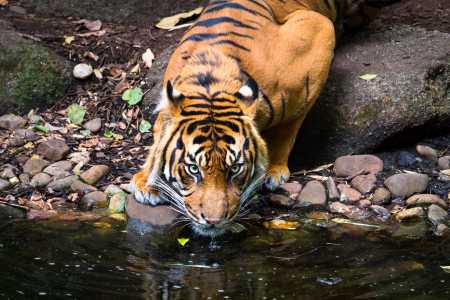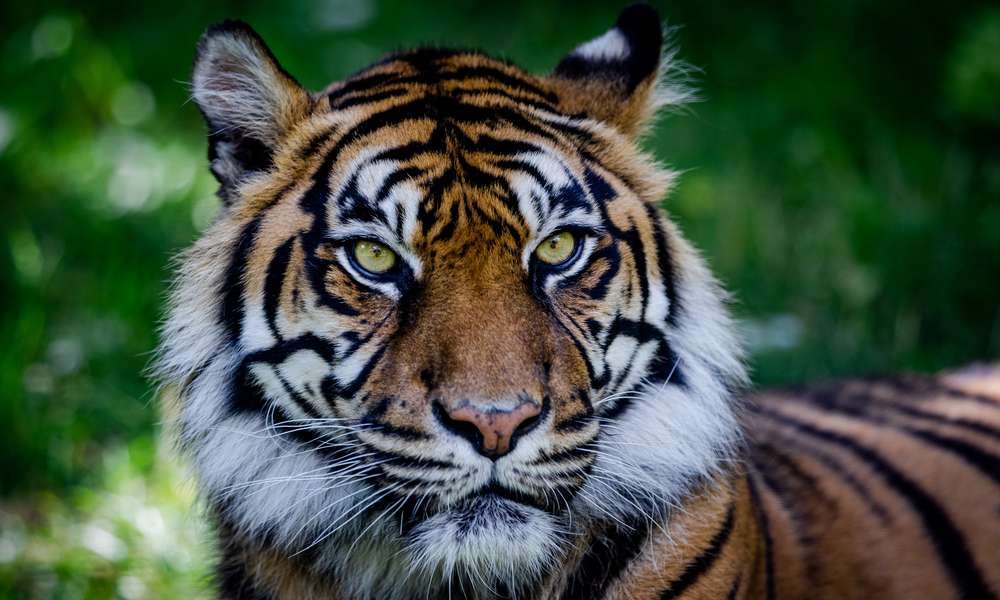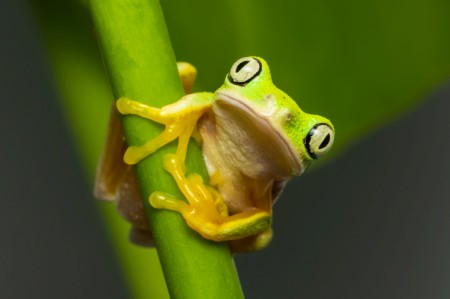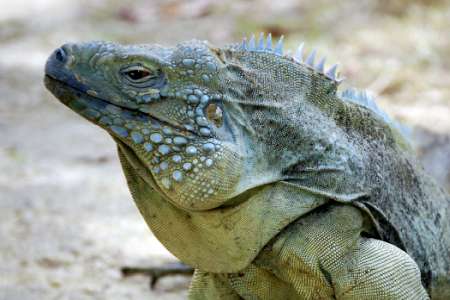

Sumatran Tiger
Magnificent, Yet So Vulnerable to Extinction!

INTRODUCTION
Sumatran tiger (Panthera tigris sondaica – formerly Panthera tigris sumatrae) is also known as the Sunda tiger, a unique subspecies of tiger that is native to the Indonesian island of Sumatra, known for its vibrant biodiversity. It is the smallest surviving tiger subspecies, and its distinguishing features have generated much interest in the scientific community.
However, the Panthera tigris sumatrae is no longer a separate subspecies. In 2017, tiger categories were updated by The International Union for Conservation of Nature’s (IUCN) Cat Specialist Group. Now, there are only two tiger subspecies. The first, Panthera tigris sondaica, includes the Sumatran tiger and the extinct Javan and Balinese tigers. The second, Panthera tigris tigris, covers the Bengal, Malayan, Indochinese, South Chinese, Siberian, and extinct Caspian tigers. The Panthera tigris was last globally evaluated for The IUCN Red List of Threatened Species in 2021, and it is currently categorized as Endangered based on criteria A2abcd.
Scientific classification
• Kingdom: Animalia
• Phylum: Chordata
• Class: Mammalia
• Order: Carnivora
• Family: Felidae
• Genus: Panthera
• Species: P. tigris
• Subspecies: P. t. sumatrae
Appearance and Behavior
Sumatran tigers have thick black stripes on their orange coats, differentiating them from other subspecies. They have a mane-like ruff of fur around their neck, and their fur is darker, which allows them to blend into their dark jungle habitat. These tigers have a more bearded and maned appearance, particularly the males, which have a prominent ruff, which is not seen in other subspecies of tigers. This physical feature gives the Sumatran tiger a distinctive and majestic look. Each tiger has a unique pattern of stripes that can be used to identify individuals, much like human fingerprints.
- Weight: up to 300 pounds (136 kg) for males and up to 200 pounds (91 kg) for females.
- Body length: up to 8 feet (2.34 meters) for males and 6.5 feet (1.98 meters) for females.
The hind legs of a Sumatran tiger are longer than their front legs, which gives them incredible leaping ability. This anatomical adaptation is particularly useful when ambushing prey. Sumatran tigers are also excellent swimmers and are known to chase their prey into the water. Unlike most cats, they enjoy bathing and will often soak in water to cool off. Being the most diminutive of the remaining tiger subspecies, Sumatran tigers are highly agile and can maneuver easily through dense forests.
Habitat and Ecology
Sumatran Tigers are found in various habitats on the island of Sumatra, Indonesia, including lowland forests, mountain forests, and peat swamp forests. They live for approximately 15-20 years in the wild and typically 16 to 18 years in captivity. These tigers are carnivorous, feeding any animals such as wild boar, deer, monkeys, fish, etc…

Sumatran tigers habitat map. Locations added. RXerself, CC BY-SA 4.0, via Wikimedia Commons
Sumatran tigers breed throughout the year, but most births occur between March and June. A female Sumatran tiger generally gives birth to one to six cubs after a gestation period of about 100 days. The cubs remain with their mother until they are about 18-24 months old, at which point they start hunting and living independently.
Conservation Status
The Sumatran tiger was listed as critically endangered on the IUCN Red List of Threatened Species in 2008. It’s estimated that there are less than 600 in the wild, and the population continues to decrease because of habitat loss, poaching, hunting, and human-wildlife conflict. The rapid deforestation and urban expansion in Sumatra are leading to significant habitat fragmentation, which puts further strain on the already dwindling tiger population. Measures to protect this magnificent species are urgently required, as its decline could also disrupt the ecological balance of its natural habitat.
THREATS TO SUMATRAN TIGERS

The Sumatran tiger, an apex predator and the smallest of the surviving tiger subspecies, is at a critical crossroads for its continued survival. It’s the only tiger subspecies left in Indonesia after the extinction of the Bali and Javan tigers. However, its continued existence is under severe threat due to many factors.
Habitat Destruction
Sumatran tigers have been hit hard by rampant habitat loss, the primary threat to their survival. Extensive deforestation has become a tremendous menace to their existence, occurring at a large scale and unimpeded rate; it threatens the survival of these majestic creatures.
The primary driver of habitat loss is the proliferation of palm oil plantations. As the global demand for palm oil continues to soar, vast expanses of the Sumatran tiger’s jungle habitat are being converted into these plantations. This agricultural encroachment severely depletes the tigers’ natural home, dramatically reducing the spaces where they can live and thrive.
Illegal logging is another significant contributor to deforestation that further exacerbates the problem. Often clandestine and unregulated, this activity leads to the indiscriminate felling of trees and severe degradation of the tigers’ habitat. As more forests fall victim to destruction, the tigers are squeezed out of their territories and left struggling to adapt to the shrinking habitats.
Human settlement expansions are yet another destructive force to the Sumatran tiger’s habitat. As human populations grow, the need for infrastructure developments correspondingly grows, and the forested areas are cleared and replaced by roads, buildings, and other human constructions.
The remaining forests are fragmented, compelling the tigers to venture out of their accustomed territories and into human-populated areas. To no one’s surprise, the forced proximity between tigers and humans often culminates in unfortunate incidents and escalating human-tiger conflicts.
Humans facing threats to their lives and livelihoods from tiger attacks naturally feel fear and resentment towards these animals. Human settlements continue encroaching upon the tiger’s habitat, increasing human-tiger conflicts. Tigers are often killed in retaliation for attacks on livestock or, on rare occasions, humans. This escalating conflict further exacerbates the threats to the tiger’s survival. For the tigers, encounters with humans result in injury, capture, or even death. This human-tiger conflict, driven by habitat loss, is another threat the Sumatran Tiger faces.
Population and Genetic Diversity
As the Sumatran Tiger’s population shrinks, the latest reports show that fewer than 400-600 individuals are estimated to roam the wild, primarily in the island’s national parks. This reduction in population size leads to decreased genetic diversity, making the tigers more vulnerable to diseases and less adaptable to environmental changes. It also raises concerns about inbreeding, which can result in congenital defects, further decreasing the population’s health and viability.
Illegal Poaching and Wildlife Trade
Despite the legal protection granted to them by both Indonesian and international laws, Sumatran tigers are highly and illegally sought after. Their pelts contain striking fur patterns and are used as home decorations and status symbols. Their bones, teeth, and other body parts are used in concocting various traditional medicines, especially within part of Asia, despite no scientific proof supporting their effectiveness.
The illegal wildlife trade industry is rampant and largely unchecked and continues to be a substantial driver behind the dwindling numbers of Sumatran tigers. Despite considerable efforts by conservation agencies and law enforcement, the underground nature of this illegal trade makes it a complex issue to tackle fully and effectively.
Competition for Prey
Wild pigs, sambar & barking deer, goats, primates such as macaques, fish, and reptiles such as crocodiles are all prey that provide sustenance for the Sumatran tiger. The tiger’s natural prey is, in many cases, a species that humans kill for food and other reasons, leading to food shortages for the tigers and forcing them to attack and kill farmed animals. This search for alternative food sources places additional stress on the tiger population and can lead to increased conflict with humans.
Predation and Disease
Sadly, humans are the most destructive predator of the Sumatran tigers. Other than humans, adult tigers have no natural predators, while young cubs are at risk from snakes, leopards, crocodiles, and even male tigers. The disease also plays a significant role in the survival of the species. Canine distemper virus and feline parvovirus are just two diseases that can devastate small, isolated populations of Sumatran tigers.
Conclusion
The plight of the Sumatran tiger paints a grim picture. It underscores the urgency of effective conservation strategies to preserve this unique species and its habitat. Addressing the complex issues of habitat loss, poaching, hunting, and human-tiger conflict is challenging. Still, a fight needs to be won to ensure the continued existence of this majestic creature.
IMPORTANCE OF SUMATRAN TIGERS

Financial Impacts of Sumatran Tiger Decline
International organizations and governments bear many immediate costs linked to conserving this species. The Sumatran tiger is not merely a magnificent creature. The decline and possible extinction of the Sumatran tiger has far-reaching effects on the local ecosystems. As apex predators, Sumatran tigers play a critical role in maintaining the balance of the habitats they inhabit. For instance, they help control prey species’ populations, which in turn helps to prevent overgrazing and preserve habitat for other species. Without the tigers in decline, considerable amounts of money are needed for research and protection measures, and these activities are partly underwritten by taxpayers in developed nations.
Effects on Climate Change and Associated Costs
The Sumatran tiger’s habitat, the Sumatra lush forests, plays a crucial role in carbon sequestration. Protecting the tiger indirectly preserves these forests and their capacity to absorb carbon dioxide, mitigating climate change. They do this by:
- Controlling Herbivore Populations: Tigers feed on herbivores like deer, wild boar, and other ungulates. By keeping these populations in check, tigers help to prevent overgrazing of vegetation, which in turn helps to maintain the health and diversity of forests.
- Promoting Biodiversity: The presence of an apex predator like the tiger helps encourage biodiversity in the ecosystem. A diverse ecosystem is generally healthier and more resilient, which means it can better withstand threats such as disease or environmental changes.
- Protecting Forests from Encroachment: Areas that are home to tigers are often given protected status, which helps to safeguard them from threats such as logging and land conversion for agriculture. By preserving tiger habitats, we’re also preserving large tracts of forest that serve as carbon sinks, absorbing CO2 and helping to mitigate climate change.
All of these factors have positive effects on climate change and other eco-related issues. Initiatives aimed at reducing carbon emissions, restoring damaged habitats, and reestablishing biodiversity without the tigers become costlier.
Impact on Agriculture
The Sumatran tiger contributes indirectly to agricultural productivity by controlling populations of herbivores that could otherwise devastate crops. A decrease in tiger populations leads to a surge in these herbivore populations, causing significant damage to agriculture, which in turn, raises operational costs for the agricultural industry. Increases to producers often translate into higher prices for agricultural goods paid by consumers.
Costs of Legislation and Enforcement
Protective measures for endangered species like the Sumatran tiger require substantial resources to enforce and monitor legislative initiatives and policies. Protecting species requires extensive legislative actions to formulate and fund policies. Payments must be made to contractors and those who police the habitat. Costs incurred in providing this protection and mitigation efforts strain budgets and fund allocation, lessening the amount of money available for other necessary programs.
Loss of Ecotourism Potential
The Sumatran tiger is a strikingly beautiful animal. Its striking appearance has significant potential for bolstering local eco-tourism. The decline or possible extinction of this species would result in a lost opportunity for eco-tourism and consequently impact local communities that could have benefited from tourist revenue. Ecotourism significantly contributes to local economies, and losses are felt beyond just those communities.
The Bottom Line for the Sumatran Tiger
The survival of this unique species has implications for global economies and citizens of local and developed countries. Its role in biodiversity and climate change mitigation underlines the importance of its conservation. While protecting biodiversity incurs significant costs, the cost of losing species like the Sumatran Tiger is even more substantial.
HOW TO HELP SUMATRAN TIGERS

Every individual’s actions contribute to the preservation or depletion of our planet’s biodiversity. The threats to various species like the Sumatran tiger are primarily driven by both local and global factors, including climate change, pollution, and habitat destruction. These issues are not confined to one area but extend across national borders and affect ecosystems worldwide. To mitigate these issues and protect threatened species, we need global leadership that recognizes the issues and international cooperation.
Understanding the Plight of Sumatran Tigers
Rapid deforestation due to palm oil production and illegal logging, coupled with human-tiger conflict and poaching for the illegal wildlife trade, are the primary drivers of their dwindling numbers. Promoting an understanding of these threats to others and taking personal actions to mitigate them is crucial. In some cases, even local populations are not aware of the importance of the tigers to their well-being, and education on the issues is a step towards preserving this majestic species.
Acting Locally to Save the Sumatran Tiger
On a local scale, one can participate in community-driven initiatives for tiger conservation. Educating communities about the ecological importance of the Sumatran tiger, its threats, and how its survival can benefit local economies can promote conservation. For instance, sustainable ecotourism and responsible agricultural practices can incentivize communities to protect these big cats.
Supporting Ethical Ecotourism
Choosing ethical tourism options, especially while visiting Sumatra, can help protect the Sumatran tiger’s habitat. Eco-tourism encourages the preservation of natural habitats and can provide much-needed funds for conservation efforts. However, it is crucial to ensure that these tourism options are low-impact, respect local rights, and truly contribute to the protection of the tigers.
Refusing to Support the Illegal Wildlife Trade
The illegal wildlife trade poses a significant threat to Sumatran tigers. Refusing to purchase products derived from endangered wildlife is something that all of us can do. Spreading awareness about the devastating impacts of this illicit trade and advocating for stricter laws and penalties against wildlife trafficking can significantly contribute to preserving Sumatran tigers. Educating others that traditional medicines based on the tiger’s bones and other body parts are not proven can reduce the killing of tigers for these products.
Backing Conservation Organizations
Non-profit organizations work tirelessly to protect the Sumatran tiger and its habitat. Contributing to these organizations through donations, volunteering, or raising awareness about their work can make a significant difference. For example, organizations like the Wildlife Conservation Society and Panthera run programs dedicated to protecting tigers and their habitats.
Reducing Our Environmental Impact
Global issues such as climate change affect the survival of Sumatran tigers, altering their habitats and prey availability. By adopting sustainable lifestyles, such as minimizing waste, using renewable energy sources, and supporting sustainable agriculture, we can help reduce our environmental impact. Global climate change is ever more present in all countries around the world. Eliminating fossil fuel use will mitigate climate change, protect tigers, and, at the same time, protect us against this threat.
Promoting Biodiversity Conservation
Protecting the Sumatran tiger is not just about saving one species but also about preserving the biodiversity of Sumatra’s rainforests. Understanding the interconnectedness of species and their roles in maintaining healthy ecosystems is crucial. By appreciating and advocating for biodiversity, we can ensure the survival of many species, including the Sumatran tiger.
In conclusion, preserving the Sumatran tiger is an international responsibility that requires collective and individual efforts. We all can contribute by raising awareness, supporting sustainable tourism, advocating for stricter wildlife trade regulations, backing conservation organizations, and electing leaders willing to support the tiger and the environment. Remember, each action, no matter how small, is a significant step towards preserving our planet’s incredible biodiversity, symbolized by the Sumatran tiger.












